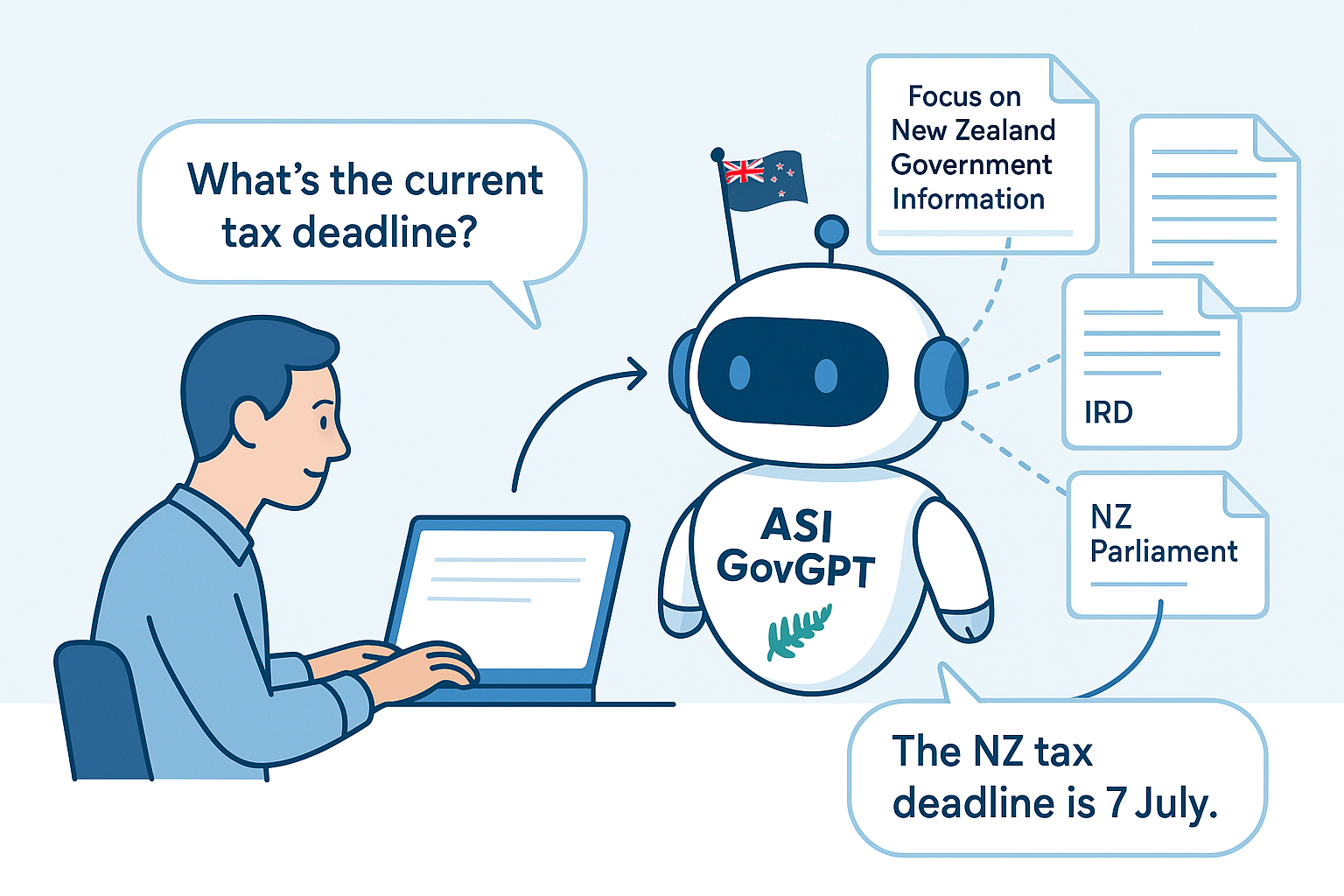
The GovGPT artificial intelligence chat bot pilot project that was launched in September last year, and then sunset in February, had some real fans, including Auckland AI company ASI Solutions. Not content with seeing the project just vanished, ASI decided to give it a go and launched its version, the free to use ASI GovGPT.
Here's a guest post from ASI's country manager Lloyd Vickery explaining how the company's GovGPT works and what makes it different from other chatbots. Published with permission from ASI Solutions.
ASI GovGPT is a new AI chatbot by ASI Solutions that helps New Zealanders find information about government services and policies. But unlike typical AI chatbots you may have seen, ASI GovGPT doesn’t just rely on a static database of old information. It’s powered by a web search-based AI model, meaning it can search the internet in real time to find the latest info before answering your questions. In this post, we’ll explain in simple terms how ASI GovGPT works and why this approach is great for Kiwis. We’ll avoid technical jargon and keep it conversational, so everyone can understand the magic behind the scenes.
What makes ASI GovGPT different?
Most AI chatbots (like some you may have tried) have a knowledge cutoff – they only “know” what was in their training data up to a certain date. Ask them about something recent (like a new policy announced last week) and they might shrug or give an outdated answer. ASI GovGPT is different: it can look up information online at the moment you ask your question. It’s like having an AI that does a quick web search for you, then summarises the answer in plain English.

Because ASI GovGPT taps into live web data, it always provides up-to-date answers. For example, if you ask, “what are the latest travel restrictions for entering New Zealand?”, GovGPT will search government websites for the current policy and give you the most current information. Traditional models that don’t search might only recall rules from a year ago, but GovGPT fetches the latest facts straight from the source.
How ASI GovGPT finds the information you need
So how exactly does ASI GovGPT use the web to answer your questions? It helps to think of it step by step. When you type a question, here’s what happens behind the scenes:
-
Understanding your question: first, the AI reads your question and figures out what you’re asking. Thanks to some built-in instructions (more on that soon), it knows you’re likely looking for information in a New Zealand government context.
-
Searching the web: next, GovGPT turns into a mini search engine. It formulates a search query based on your question – basically, it decides what keywords or phrases to look up. Then it searches the internet for relevant pages. This might include New Zealand government sites, official news updates, or other credible sources related to your question.
-
Finding the best sources: once the search results come in, the AI quickly scans the top results. It retrieves and reads through the most relevant sources, much like you would skim a few web pages to find an answer. At this stage, it’s gathering facts and data. Importantly, it also ranks the sources to figure out which ones are the most trustworthy and relevant (for example, a .govt.nz website or a recent press release would rank high as a reliable source).
-
Composing an answer: after pulling in information from these sources, ASI GovGPT then writes a concise answer to your question. It uses simple, clear language to explain the information it found. Rather than quoting a whole webpage, it summarises the key points for you. If multiple sources had useful tidbits, it will combine them into one coherent response.
-
Citing or referring to sources (when appropriate): in many cases, GovGPT will also let you know where it got the information. It may refer to the website or document it used, especially if you need to follow up for more detail. This way you not only get an answer, but you have confidence it’s grounded in something real and recent (not just made up by the AI).
By performing these steps in seconds, ASI GovGPT acts like both a smart librarian and a knowledgeable guide. It finds the information for you and then explains it in a friendly way. The crucial takeaway is that GovGPT’s answers aren’t coming out of a stale archive or solely from memory – they’re pulled from the latest available information on the web each time you ask.
Staying focused on New Zealand: the special NZ prompt
You might be wondering, “How does GovGPT know to focus only on New Zealand government info?” This is where a clever technique called a “system prompt” comes in. Essentially, before ASI GovGPT starts chatting with users, it’s given a set of guiding instructions (the system prompt). Think of this like an instruction manual or a mission statement for the AI. In GovGPT’s case, the prompt tells it something along the lines of:“you are an AI assistant that helps users find information about New Zealand government services and policies.”
By programming this context upfront, the AI is steered towards NZ-related information whenever possible. For example, if you ask about “the tax deadline,” the system prompt ensures that GovGPT interprets that as the New Zealand tax deadline (likely referring to Inland Revenue deadlines), not some other country’s. It’s as if the AI has a Kiwi lens on everything it sees. If a query is too broad or not obviously about New Zealand, GovGPT will either clarify or default to information that’s relevant to New Zealand.
These New Zealand-focused instructions also help filter out irrelevant info. If someone accidentally asks GovGPT something unrelated to government or New Zealand (say, a random personal question or something about another country’s policies), the AI can politely steer the conversation back, or explain that its expertise is in NZ government topics. This keeps the interaction on track and useful for the intended purpose.
In short, the system prompt acts as a compass, always pointing GovGPT toward content that serves New Zealanders’ needs. It was much quicker to set this up with instructions than to train a whole new AI on volumes of NZ data. And it works remarkably well: you get answers that feel tailored to New Zealand, without the developers having to build a bespoke NZ model from scratch.
Why this approach? Benefits of a web‑connected AI
ASI Solutions chose to build GovGPT this way – using an existing AI model with web search and a New Zealand guide prompt – for some very good reasons. Here are the big advantages of this approach:
-
Always up-to-date answers: because GovGPT searches the live web, it can deliver information that’s current. Government policies and services change over time, and new information comes out frequently. GovGPT will catch those updates. You won’t get stuck with year-old data or outdated advice since it’s pulling answers from today’s information.
-
No need to manage huge datasets: Traditional AI models often require feeding in massive amounts of training data (and constantly updating that data). With GovGPT, there’s no giant custom database that needs constant maintenance. The AI simply uses what’s already out there on the internet. This means the team doesn’t have to gather, clean, and update a special dataset of NZ government info – the model finds the info on the fly.
-
Faster to deploy and improve: Building and fine-tuning a custom AI model can take months (and lots of money). Instead, ASI Solutions leveraged an already powerful AI and just guided it for the NZ context. This way, GovGPT was up and running quickly – in fact, the team was able to deploy it in a matter of days once the need arose. If improvements are needed, they can tweak the system prompt or the search strategy without retraining an entire model. That means new features or adjustments can roll out much faster.
-
Cost-effective and scalable: Using an existing AI service with web search is generally more cost-effective than training and hosting a giant custom model. There’s no expensive training phase, and the computational load is mainly when processing user questions and doing searches. This efficient approach helped ASI Solutions deploy GovGPT as a free service for the public, and it will be easier to scale as more people use it, without breaking the bank.
-
Focused and relevant responses: The combination of the NZ-specific prompt and live search means GovGPT’s answers stay on-topic and relevant to New Zealanders. Users don’t have to sift through generic answers or information from other countries. Each answer is informed by sources that matter here at home (like govt.nz portals, local news, and official announcements), making the advice more trustworthy for Kiwi readers.
By capitalising on these advantages, ASI GovGPT delivers a reliable and user-friendly experience. It demonstrates a smart way to use AI without reinventing the wheel – take a robust existing model, plug in real-time knowledge, and steer it with the right instructions.
Bringing it all together
In a nutshell, ASI GovGPT works by combining the strengths of a world-class language AI with the vast, up-to-date information available on the web, all guided by a New Zealand-specific focus. It’s a bit like having a knowledgeable friend who knows where to find any answer online, and who also happens to understand Kiwi culture and government lingo. This approach allowed ASI Solutions to launch a helpful tool for the public quickly and cost-effectively, without compromising on the quality of information.
The next time you ask ASI GovGPT a question about, say, government funding for a small business or the details of a public policy, remember what’s happening behind the scenes. The AI is diligently searching the internet, picking out the best bits from trusted sources, and tailoring the answer just for you – all in a matter of seconds. And because of its design, you can trust that the answer is not only clear and jargon-free, but also based on the latest facts available.
ASI GovGPT showcases how AI technology can be used in a practical, transparent way to benefit everyone. By staying current, being locally aware, and avoiding the heavy lifting of building a model from scratch, it provides a service that’s both smart and accessible. Give it a try with your own questions – you’ll be engaging with an AI that truly keeps its ear to the ground (or rather, its eyes on the web) for New Zealand. Happy chatting!

We welcome your comments below. If you are not already registered, please register to comment.
Remember we welcome robust, respectful and insightful debate. We don't welcome abusive or defamatory comments and will de-register those repeatedly making such comments. Our current comment policy is here.